 the smartest primates
the smartest primates |
|
|
|
|
|
|
|
|
| |
| |
|

often confused for a monkey , but actually an ape |
|
|
|
|
|
|
|
Can you tell the difference between an ape and a monkey? Many people call all primates monkeys, when in fact apes and monkeys are two kinds of animals under the classification of primate. They may look similar, but when you start to learn more about them, it becomes apparent there are many differences between monkeys and apes. Which animals are monkeys, and which are apes?
|
|
Possible Advertisement
|
|
 There
are many many differences between monkeys and apes. But let's list some basics to remember right now. . There are only a small number of types of apes, while there are over a hundred types of monkeys. This article will focus more on apes: There
are many many differences between monkeys and apes. But let's list some basics to remember right now. . There are only a small number of types of apes, while there are over a hundred types of monkeys. This article will focus more on apes:
- Apes are usually larger and heavier than monkeys.
- Apes have no tail.
- Apes have a more upright body posture than monkeys, and are often able to walk on 2 legs.
- Apes have a broad chest.
- Apes rely on vision rather than smell, and thus have shorter noses than some monkeys.
- Apes have a large brain to body size ratio compared with other animals.
- Apes only live in Africa and Asia (monkeys also live in South America).
There are a few exceptions to these rules; there are some monkeys without tails, and there are some large monkeys. But overall, those are general characteristics to remember about apes and monkeys.
 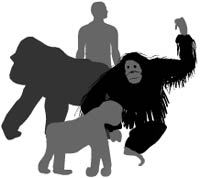
Now... let's talk a little more about some of these apes. Already after reading the list above, some things look familiar to you. That's because humans are apes! Humans are part of the category "Great Apes". The Great Apes have characteristics that set them apart from other apes and primates:
- The Great Apes are able to use tools, and use language.
- Their social lives are complex and they are able to solve problems.
Who? The great apes include orangutans, chimpanzees, orangutans, gorillas, humans and bonobos (shown below in order). These great apes are included under the family Hominidae.

Great ape appearance: In appearance the great apes have many similarities. The face is almost naked, and the ears are round and mostly hairless. They do not have cheek pouches. The thumb is shorter than the fingers and opposable. Except for the human, the arms are longer than the legs and the big toe is also opposable. All have the ability to walk bipedally (on two legs), though some do it more than others like humans and bonobos.
Great ape sense: All the great apes can distinguish colors, and rely mostly on vision and hearing rather than smell. They have a wide range of vocalizations, and facial expressions.
Great ape smarts: As stated above, the great apes are intelligent, capable thinkers and able to problem solve and learn language.
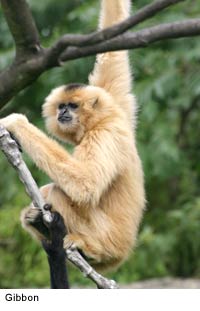 Besides the Great Apes, who are the other apes? Besides the Great Apes, who are the other apes?
There are a few other apes in addition to the great apes, called the "lesser apes". The family Hylobatidae consists of many species of gibbons. They are different physically, socially and mentally from the great apes (chimpanzees, gorillas, orangutans and humans). They are smaller in size, and unlike the great apes which live in complex social groups, gibbons live in pairs for life. They don't make nests like most of the great apes, and in some ways, they look more similar to monkeys than the great apes.
Lesser Apes - Gibbons
Though on the surface they may look like monkeys because of their smaller and more slender forms, gibbons are indeed apes. Like the great apes, they lack tails, and have the same dental formula. Their skulls are also similar to those of great apes, having enlarged braincases and huge eye orbits that face forward. Siamangs are the largest type of gibbon.
The most dangerous ape: All the apes except one are endangered. Which ape is not endangered? The one that is causing their fellow apes to become endangered - humans. Humans continually destroy other ape habitat with logging, farming and housing expansion, and also often hunt apes for bushmeat. Many of the apes are critically endangered because of humans.

As stated before, apes only live in Africa and Asia, whereas other primates also live in South America.
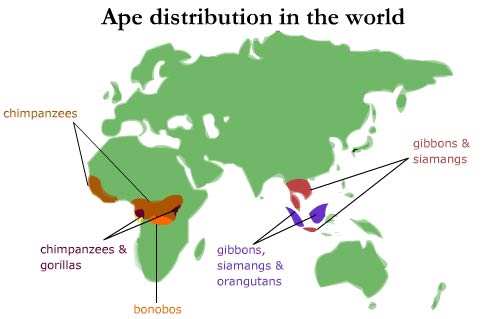
|

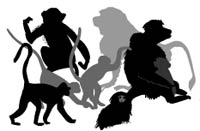 Briefly on Monkeys: Monkeys have the most variation among the Primates, and there are many kinds of monkeys. Monkeys themselves are divided into two large categories: Old World Monkeys and New World Monkeys. Old World monkeys live in Africa and Asia, and New World Monkeys live in Central and South America. Briefly on Monkeys: Monkeys have the most variation among the Primates, and there are many kinds of monkeys. Monkeys themselves are divided into two large categories: Old World Monkeys and New World Monkeys. Old World monkeys live in Africa and Asia, and New World Monkeys live in Central and South America.
Old World Monkeys: Old World Monkeys make the family Cercopithecinae. They are larger than the New World monkeys. They are diurnal, and are physically different as well. Old world monkeys have:
- Narrow and downward pointing nostrils.
- Longer hind legs than forearms.
- Flattened
nails on fingers and toes.
- Prominent buttock pads that they can sit on.
- Tails, but not prehensile (adapted for grasping or holding) ones.
- They are generally larger than the New World monkeys.
Old world monkeys themselves are divided into two subfamilies: the Cercopithecinae (cheek-pouched monkeys) and the Colobinae (leaf-eating monkeys).

New World Monkeys: These monkeys live in the neotropical forests of the "new world".New World Monkeys range vastly in size - some are quite tiny, like the 6 inch pygmy marmoset, and some are larger - the howler monkey can be up to 3 feet in length. New World Monkeys are called platyrrhines. Characteristics of New World Monkeys:
- Wide nostrils which are circular and spaced apart.
- They are small to medium sized.
- Long tails which are sometimes prehensile.
- No buttock pads.
- No cheek pouches.
They are divided into two groups: The Callitrichidae, which include the smaller tamarins and marmosets, and the Cebide Monkeys, which include a wider variety of monkeys including the capuchin, owl, titi, saki, spider, wooly, and many others.
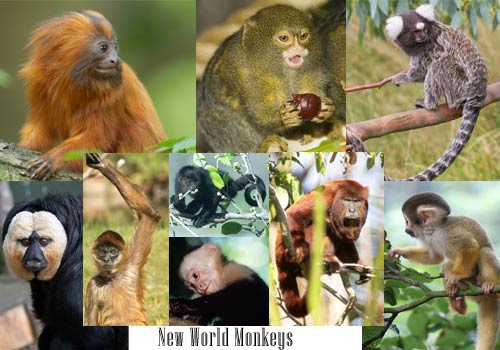
As you may start to discover from the photos, there are many kinds of monkeys (both New World and Old World) - many more than the apes, and also more than the next kind of primate, one much less well-known....
Possible Advertisement

 Not a monkey OR an ape: There is one other kind of primate that people may not be aware of. Prosimians are the most primitive of the primates - sometimes they are referred to as "pre-monkeys". There name means "before monkeys". Not a monkey OR an ape: There is one other kind of primate that people may not be aware of. Prosimians are the most primitive of the primates - sometimes they are referred to as "pre-monkeys". There name means "before monkeys".
Prosimians include animals like lemurs, lorises, and tarsiers. They are the ancestors to monkeys, and apes and live a very different lifestyle.
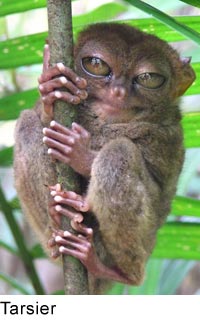 Nocturnal and sensitive: In contrast to diurnal (daytime) monkeys and apes, prosimians are mostly nocturnal... they have large eyes with sensitive nocturnal vision, complex tactile hairs, large and independently movable ears and a strong sense of smell. Nocturnal and sensitive: In contrast to diurnal (daytime) monkeys and apes, prosimians are mostly nocturnal... they have large eyes with sensitive nocturnal vision, complex tactile hairs, large and independently movable ears and a strong sense of smell.
Specialized and tropical; They are usually very specialized to their environment and have a variety of social systems. Like monkeys and apes though, they do have a developed hand with good control. They are restricted to living only in tropical woodlands...
Prosimians are restricted to tropical woodlands. Many surviving species have become nocturnal, probably because of competition from diurnal monkeys and rodents. Most prosimians are endangered, some critically so.

Prosimians have:
- A well developed sense of smell, and a more prominent snout.
- Partial binocular vision (using two eyes together, as apes and monkeys do). Often nocturnal vision.
- Some claws and developed manual dexterity.
- Immobilized upper lips.
- A different dental formula - 2:1:3:3
- Prosimians only live in the 'Old World'. (area that don't include North and South America): Lemurs live only on the island of Madagascar, Tarsiers live on the islands of the Philippines, Borneo, Celebes Islands, and Sumatra, and Lorises live in areas of Africa and South/Southeast Asia .

Hopefully now you know some characteristics, both physically and otherwise that separate monkeys and apes - as well as the other less well known primate (Prosimians). Here is one more graphical reminder, to help you be able to recognize the different kinds of primates since there are very obvious physical differences between them! Good luck!
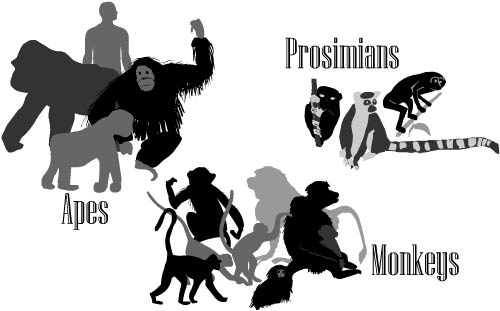
Bonobos | Chimpanzees |Gorilla| Humans | Orangutans | Gibbons
Baboon | Howler Monkey | Lion Tamarin | Marmoset| Mandrill | Patas Monkey | Squirrel Monkey
Lemurs| Lorises| Tarsiers
Primates| Apes| Monkeys| Prosimians
|
|
|